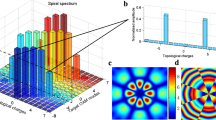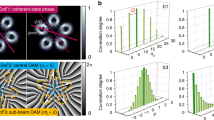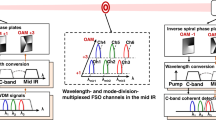Abstract
Increasing the information capacity per unit bandwidth has been a perennial goal of scientists and engineers1. Multiplexing of independent degrees of freedom, such as wavelength, polarization and more recently space, has been a preferred method to increase capacity2,3 in both radiofrequency and optical communication. Orbital angular momentum, a physical property of electromagnetic waves discovered recently4, has been proposed as a new degree of freedom for multiplexing to achieve capacity beyond conventional multiplexing techniques5,6,7,8,9, and has generated widespread and significant interest in the scientific community10,11,12,13,14. However, the capacity of orbital angular momentum multiplexing has not been established or compared to other multiplexing techniques. Here, we show that orbital angular momentum multiplexing is not an optimal technique for realizing the capacity limits of a free-space communication channel15,16,17 and is outperformed by both conventional line-of-sight multi-input multi-output transmission and spatial-mode multiplexing.
This is a preview of subscription content, access via your institution
Access options
Subscribe to this journal
Receive 12 print issues and online access
$209.00 per year
only $17.42 per issue
Buy this article
- Purchase on Springer Link
- Instant access to full article PDF
Prices may be subject to local taxes which are calculated during checkout



Similar content being viewed by others
Change history
27 November 2015
In the version of this Letter originally published, in Fig. 3a,b, the x axis labels should have been ‘SNR (dB)’. This has now been corrected in the online versions of the Letter.
References
Shannon, C. E. A mathematical theory of communication. Bell Syst. Tech. J. 23, 45 (1948).
Ng, S. X., Hanzo, L. L., Keller, T. & Webb, W. Quadrature Amplitude Modulation: From Basics to Adaptive Trellis-Coded, Turbo-Equalised and Space–Time Coded OFDM, CDMA and MC-CDMA Systems (Wiley-IEEE, 2004).
Evangelides, S. G. Jr, Mollenauer, L. F., Gordon, J. P. & Bergano, N. S. Polarization multiplexing with solitons. J. Lightw. Technol. 10, 28–35 (1992).
Allen, L., Beijersbergen, M. W., Spreeuw, R. J. C. & Woerdman, J. P. Orbital angular momentum of light and the transformation of Laguerre–Gaussian laser modes. Phys. Rev. A 45, 8185–8189 (1992).
Fabrizio, T. et al. Encoding many channels on the same frequency through radio vorticity: first experimental test. New J. Phys. 14, 033001 (2012).
Willner, A. E., Wang, J. & Huang, H. A different angle on light communications. Science 337, 655–656 (2012).
Wang, J. et al. Terabit free-space data transmission employing orbital angular momentum multiplexing. Nature Photon. 6, 488–496 (2012).
Yan, Y. et al. High-capacity millimetre-wave communications with orbital angular momentum multiplexing. Nature Commun. 5, 4876 (2014).
Bozinovic, N. et al. Terabit-scale orbital angular momentum mode division multiplexing in fibers. Science 340, 1545–1548 (2013).
Cartiledge, E. Adding a twist to radio technology: spiralling radio waves could revolutionize telecommunications. Nature http://dx.doi.org/10.1038/news.2011.114 (2011).
Edfors, O. & Johansson, A. J. Is orbital angular momentum (OAM) based radio communication an unexploited area? IEEE Trans. Antennas Propag. 60, 1126–1131 (2012).
Michele, T., Christophe, C. & Julien, P.-C. Comment on ‘Reply to Comment on “Encoding many channels on the same frequency through radio vorticity: first experimental test” ’. New J. Phys. 15, 078001 (2013).
Tamburini, F. et al. Reply to Comment on “Encoding many channels on the same frequency through radio vorticity: first experimental test”. New J. Phys. 14, 118002 (2012).
Kish, L. B. & Nevels, R. D. Twisted radio waves and twisted thermodynamics. PLoS ONE 8, e56086 (2013).
Mair, A., Vaziri, A., Weihs, G. & Zeilinger, A. Entanglement of the orbital angular momentum states of photons. Nature 412, 313–316 (2001).
Molina-Terriza, G., Torres, J. P. & Torner, L. Twisted photons. Nature Phys. 3, 305–310 (2007).
Saleh, M. F., Di Giuseppe, G., Saleh, B. E. A. & Teich, M. C. Photonic circuits for generating modal, spectral, and polarization entanglement. IEEE Photon. J. 2, 736–752 (2010).
Karimi, E. et al. Generating optical orbital angular momentum at visible wavelengths using a plasmonic metasurface. Light Sci. Appl. 3, e167 (2014).
Xinlu, G. et al. Generating, multiplexing/demultiplexing and receiving the orbital angular momentum of radio frequency signals using an optical true time delay unit. J. Opt. 15, 105401 (2013).
Cai, X. et al. Integrated compact optical vortex beam emitters. Science 338, 363–366 (2012).
Strain, M. J. et al. Fast electrical switching of orbital angular momentum modes using ultra-compact integrated vortex emitters. Nature Commun. 5, 4856 (2014).
Mirhosseini, M., Malik, M., Shi, Z. & Boyd, R. W. Efficient separation of the orbital angular momentum eigenstates of light. Nature Commun. 4, ( 2013).
Genevet, P., Lin, J., Kats, M. A. & Capasso, F. Holographic detection of the orbital angular momentum of light with plasmonic photodiodes. Nature Commun. 3, 1278 (2012).
Phillips, R. L. & Andrews, L. C. Spot size and divergence for Laguerre Gaussian beams of any order. Appl. Opt. 22, 643–644 (1983).
O'Sullivan, M. N., Mirhosseini, M., Malik, M. & Boyd, R. W. Near-perfect sorting of orbital angular momentum and angular position states of light. Opt. Express 20, 24444 (2012).
Lavery, M. P. J. et al. The efficient sorting of light's orbital angular momentum for optical communications. Proc. SPIE 8542, 85421R (2012).
Berkhout, G. C. G., Lavery, M. P. J., Courtial, J., Beijersbergen, M. W. & Padgett, M. J. Efficient sorting of orbital angular momentum states of light. Phys. Rev. Lett. 105, 153601 (2010).
Richardson, D. J., Fini, J. M. & Nelson, L. E. Space-division multiplexing in optical fibres. Nature Photon. 7, 354–362 (2013).
Foschini, G. J. Layered space–time architecture for wireless communication in a fading environment when using multi-element antennas. Bell Labs Tech. J. 1, 41–59 (1996).
Goodman, J. W. Introduction to Fourier Optics (McGraw Hill, 1996).
Wells, D. The Penguin Book of Curious and Interesting Numbers Revised Edition (Penguin, 1986).
Ren, Y. et al. Atmospheric turbulence effects on the performance of a free space optical link employing orbital angular momentum multiplexing. Opt. Lett. 38, 4062–4065 (2013).
Li, G., Bai, N., Zhao, N. & Xia, C. Space-division multiplexing: the next frontier in optical communication. Adv. Opt. Photon. 6, 413–487 (2014).
Cover, T. & Thomas, J. A. Elements of Information Theory (Wiley, 2012).
Shiu, D.-S., Foschini, G. J., Gans, M. J. & Kahn, J. M. Fading correlation and its effect on the capacity of multielement antenna systems. IEEE Trans. Commun. 48, 502–513 (2000).
Acknowledgements
This work was supported in part by the National Key Basic Research Program of China (973), project #2014CB340104/3, NSFC projects 61377076, 61307085 and 61431009.
Author information
Authors and Affiliations
Contributions
N.Z., G.L. and J.M.K. conceived and designed the theoretical model. N.Z. and X.L. performed the simulations. N.Z., G.L. and J.M.K. analysed the data. N.Z., G.L. and J.M.K. co-wrote the paper.
Corresponding authors
Ethics declarations
Competing interests
The authors declare no competing financial interests.
Supplementary information
Supplementary information
Supplementary information (PDF 699 kb)
Rights and permissions
About this article
Cite this article
Zhao, N., Li, X., Li, G. et al. Capacity limits of spatially multiplexed free-space communication. Nature Photon 9, 822–826 (2015). https://doi.org/10.1038/nphoton.2015.214
Received:
Accepted:
Published:
Issue Date:
DOI: https://doi.org/10.1038/nphoton.2015.214
This article is cited by
-
Performance Comparison of 2 × 120 OAM Polarized Hybrid Multiplexed FSO System in Heavy Rain and Wet-Snow Weather Conditions
Wireless Personal Communications (2024)
-
Metamaterial-based real-time communication with high information density by multipath twisting of acoustic wave
Nature Communications (2022)
-
Towards higher-dimensional structured light
Light: Science & Applications (2022)
-
Divergence-degenerate spatial multiplexing towards future ultrahigh capacity, low error-rate optical communications
Light: Science & Applications (2022)
-
Rising complexity of the OAM beam structure as a way to a higher data capacity
Light: Science & Applications (2022)



